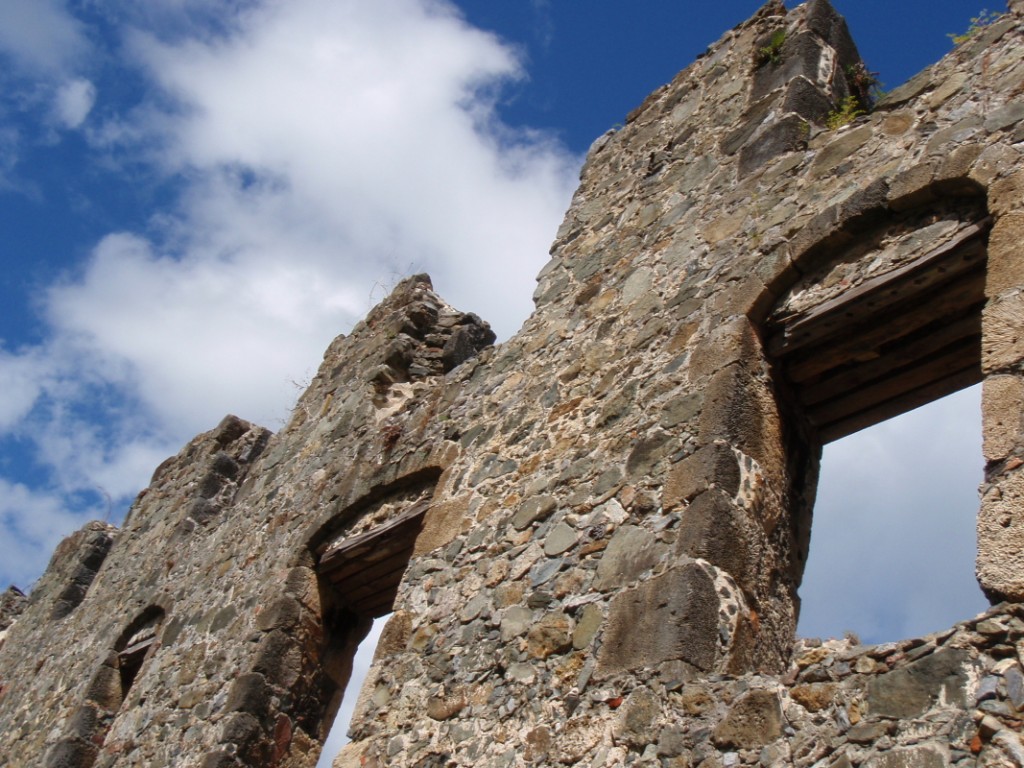
Arched stone windows on the wall of what was once the cooling room at the Annaberg Sugar Mill. Photo © Roy Montgomery, licensed Creative Commons Attribution
The Virgin Islands’ astounding beauty has long overshadowed their unique history—at least in the eyes of most visitors. But for people interested in learning about the islands’ fascinating past, there is plenty to see and do. St. Croix is the best base for historical and cultural exploration.
Downtown Charlotte Amalie is a pleasant jumble of historic buildings, cobbled alleyways, and converted sugar warehouses. Explore King’s Quarter: climb 99 Steps to Blackbeard’s Castle. Admire Fort Christian, a red-brick fortress on the St. Thomas waterfront, and visit the St. Thomas Synagogue, one of the oldest synagogues in the Western Hemisphere. Take a kayak tour to Hassel Island to tour old forts and the remains of a fascinating marine railroad.
Annaberg Plantation, deep within the Virgin Islands National Park, is a quiet reminder of St. John’s plantation past. The petroglyphs in Reef Bay were carved by the hands of prehistoric residents of St. John; learn more about them at the archaeology lab at Cinnamon Bay.
Christiansted is an exquisite Danish colonial harbor town. Tour Fort Christiansvaern, a yellow fortress on the waterfront, and admire the lovely St. Croix Government House. Search for the place where U.S. Treasury Secretary Alexander Hamilton was raised, and learn about the pre-Columbian peoples at the St. Croix Archaeology Museum.
See Salt River Bay, where Christopher Columbus landed during his second voyage to the Caribbean, and then take a guided hike to Maroon Ridge, where escaped slaves lived in the remote hills before emancipation.
In the countryside, count the number of windmill ruins you can spot and tour an elegant restored great house at Whim Plantation Museum. Head to the foothills of the rainforest to see a St. Croix–style farmhouse at the Lawaetz Family Museum. Stand beneath a baobab tree, planted by slaves at Estate Butler Bay.
In St. Croix’s second city, Frederiksted, you will find its most picturesque fort, the red-brick Fort Frederik. Fort Frederik Museum recounts the story of St. Croix’s successful slave uprising, which culminated here.
In Road Town, three museums tell of the BVI’s history: Old Government House Museum is a monument to its colonial past, while the Virgin Islands Folk Museum and the Lower Estate Sugar Works Museum celebrate the culture and accomplishments of native Virgin Islanders.
On an island tour, drive past the Fahie Hill Mural, which depicts life on the island before widespread development.
Breathe the rum-soaked air at Callwood Rum Distillery, where little has changed in the manufacture of rum in more than 200 years. Take a picnic lunch to Mount Healthy National Park, the site of Tortola’s only remaining windmill ruin.
Drive out to Coppermine Point to see the ruins of a mining operation built by Cornish miners.
Dive the wreck of the RMS Rhone off the coast of Salt Island. Come ashore at Salt Island to see what remains of a traditional island settlement and to visit the windswept burial ground of the Rhone victims.
See a collection of coins, tools, crockery, and other remnants of ships wrecked on Anegada’s treacherous reef at Pomato Point Museum.
Excerpted from the Fifth Edition of Moon Virgin Islands.